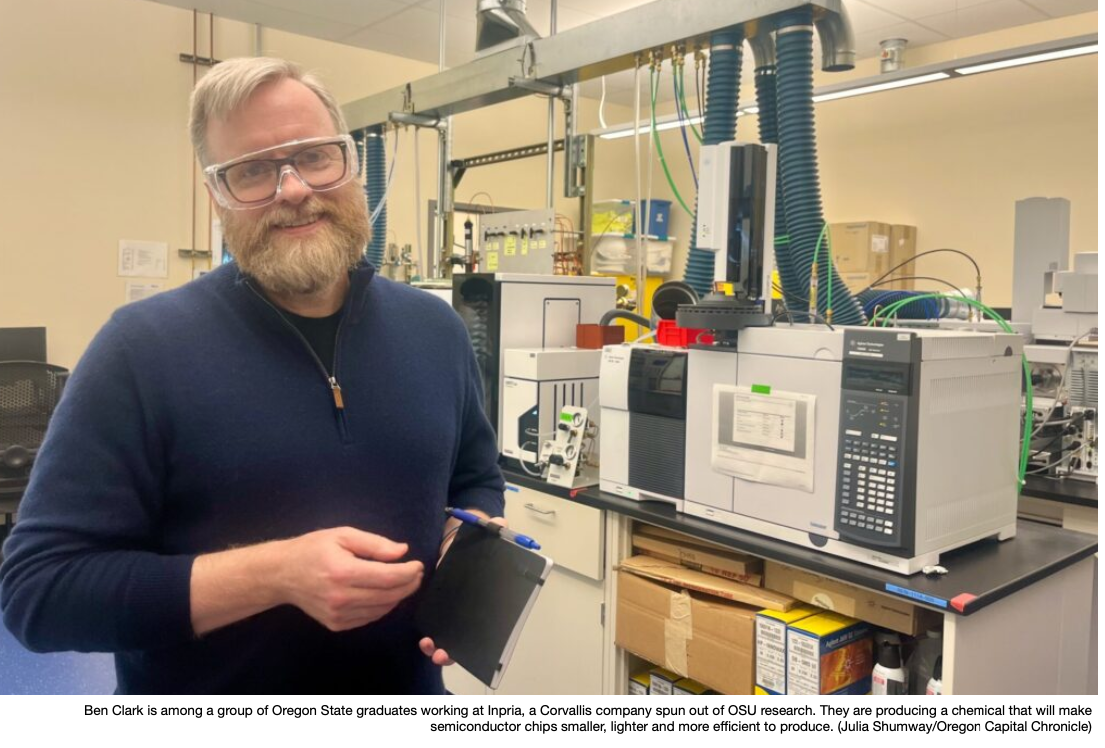Smaller Oregon companies looking for semiconductor funding

CORVALLIS— In a small laboratory on HP’s Corvallis campus, a group of Oregon State University graduates are producing a chemical that will make semiconductor chips smaller, lighter and more efficient to produce.
The company, Inpria, was born out of an Oregon State University professor’s research group about 15 years ago. Now, it has 60 employees, 50 in Corvallis and 10 in Belgium. Most, including Ben Clark, Inpria’s senior vice president of engineering, graduated from OSU.
“If things go to plan, our technology should be in phones that are manufactured three years from now,” Clark told reporters and legislators on a recent tour of HP and Oregon State University’s Advanced Technology and Manufacturing Institute.
Much of the conversation around semiconductor funding and the competition among states for new federal funding has focused on new large-scale fabrication facilities, or “fabs.” Those fabs, like several Intel locations in the Hillsboro area, can require hundreds of acres and billions of dollars to build. And in Oregon, they’re unlikely to be built outside of the Portland area.
But throughout the rest of the state, a network of smaller companies contribute to manufacturing semiconductor chips. As Oregon lawmakers prepare their pitch for spending $200 million to attract the state’s share of $53 billion in available federal grants and tax credits intended to grow the domestic semiconductor industry, they’re hearing from universities and companies with smaller workforces than Intel’s 22,000 Oregon employees.
That includes HP Inc., the technology company that spun out from printer giant Hewlett-Packard, and that has said it will bring some manufacturing jobs back to Corvallis if it receives a share of federal funding from last year’s CHIPS and Science Act.
The company has about 51,000 employees worldwide, with 2,500 employees or contractors in a 2 million square-foot facility in Corvallis. The site works closely with Oregon State University, employing 80-100 interns each year and hiring many of them full time after graduation, said Sue Richards, a former intern who’s now the global head of print microfluidics, technology and operations at HP.
“We create really great, good-paying jobs here,” Richards told legislators before they began their tour.
HP did not allow reporters to join legislators on their tour of its facilities, citing proprietary information. But after the tour, Rep. Janelle Bynum, D-Clackamas and co-chair of the Legislature’s Joint Semiconductor Committee, said she was surprised by the “ordinariness” of the products HP made.
“We all have a printer in our home, and I never thought that a chip was in there,” she said. “I don’t know what I thought was in the little printer cartridges – I just know I’m annoyed that I have to buy them – but there was an ordinariness to what they were producing.”
Americans take for granted the fact that ordinary technologies, like the HP printheads, were developed in the U.S. and can be produced elsewhere, Bynum continued. Recent supply chain issues tied to the COVID pandemic that resulted in semiconductor shortages affecting a wide swath of industries highlighted a need to produce more semiconductors in the U.S.
Bynum has a degree in electrical engineering and worked as an associate at Boeing but now owns several Portland-area McDonald’s restaurants because she couldn’t find a job in her field when she moved to Oregon. She said growing the semiconductor industry also means making sure that a diverse group of students have the opportunity to work in a high-paying industry.
The industry has a better return on investment than many fields, whether people are coming out of high school or community college and taking manufacturing apprenticeships or graduating with high-level degrees, Bynum said.
“We shouldn’t walk away from our Silicon Forest, like we did 20 years ago when I came here,” she said. “I’m an engineer and there was nothing for me. We shouldn’t walk away from that investment again.”
Bynum said she was impressed by HP, where she saw a diverse workforce. But she said OSU’s demographics need to improve. The college of engineering has about 8,000 male students and only 2,400 female students, and about one-third of the student body are people of color.
“There’s no shortage of smart kids who are first-generation college students, who are Black, who are Latino, who have come from migrant farms, who have been in the foster care system, who have been incarcerated,” Bynum said. “There is no shortage of talent in this state.”
The legislative semiconductor committee tentatively plans to vote Wednesday on a bill to create a $190 million fund for semiconductor companies to expand in Oregon, give universities $10 million to research semiconductors and grant Gov. Tina Kotek the authority to sidestep lengthy land use applications to quickly make land outside city limits developable for semiconductor manufacturing.
By: Julia Shumway
Oregon Capital Chronicle 3/7/2023


Advertisement